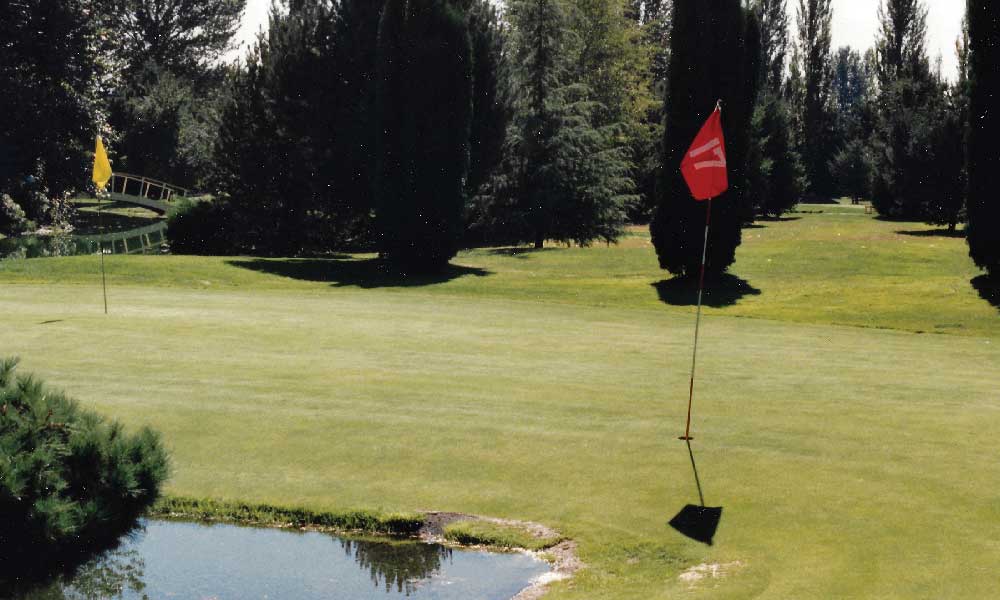This column features the author’s recollections of his 33 years as a golf writer. These installments stem from his many travels and experiences, which led to a gradual understanding that the game has many intriguing components, especially its people.
Anecdotes, Observations & Other Cosmic Golf Experiences
I recently have been seeking uplifting subjects to think – and write – about. These random memories from my native Washington State may offer a diversion during these pandemic times.
- I have carded two holes-in-one. Oddly, both happened on the 11th hole at my home club of Sand Point in Seattle. The first ace came after I hurriedly drove my wife to top of a hill above the club’s entry road so she could walk home. During this period as a beginning player, Anni would occasionally lapse into what she termed “suicide golf” mode. When things went south on the golf course, she did too. My buddy Walter had already teed off and was waiting for me. I walked briskly to the tee and, without a practice swing, smacked an 8-iron. Walt and I watched the ball disappear into the hole. Since the cup was not damaged and the stick unhit, I call this an “immaculate reception.”
- The second came during a Saturday haggle with three pals. We had the usual Nassau game along with side bets of KPs, birdies, chippies and sandies. There were three carryover KPs riding on the hole. Swede was quite pleased when his tee ball stopped 4 feet from the cup at the 11th’s toughest pin position on a sliver of green behind a bunker. Hitting last, my ball gently landed on the back side of the trap and rolled into the hole. The look on Swede’s face was priceless.
- A most unusual “site prep” for a golf course came at Three Rivers in Kelso. On property owned by the Kelso Elks Lodge, the 18-hole layout was built upon thousands of tons of dust, ash and mud that clogged the nearby Cowlitz River following the May 18, 1980, eruption of Mount St. Helens. The dredging operation was handled by the U.S. Army Corps of Engineers. Named after the Columbia, Cowlitz and Toutle (pronounced “Tootle”) rivers, the course opened in 1982. Its porous underlayment makes Three Rivers among the driest year-round courses situated in West Coast rain belts.
- Once played Kayak Point in Stanwood with my late, great friend Bob Spiwak (featured in Part 8 of this column) and his son Scott. Off the tee at the par-5 second lurked a massive boulder about 30 feet high and 40 feet across. Scott yanked a lousy drive that left him 30 yards behind the rock. I sensed things might go awry when he pulled out a 3-wood. Sure enough, his shot struck the giant stone dead-on and the ball rocketed right back at him at supersonic speed. Scott dove out of the way as the ball arced majestically 130 yards over his head into an out-of-bounds forest.
- Played a round at Gold Mountain’s superb Olympic Course before it opened. I was doing a story about the new layout (which later hosted the 2006 U.S. Men’s Amateur Public Links) and its architect, John Harbottle III. Accompanying me were Walter, Seattle’s Golf Manager John Mallon, and my sister-in-law’s boyfriend, Brad. Brad and John M. wanted a game, the losers buying dinner. Fine. All the way around I had John H’s ear, asking him questions like, “Where should I hit this shot?” and surreptitiously relaying the intel to Walt. But not the other two. The surf-and-turf dinners and drinks my partner and I enjoyed later were extra delicious.
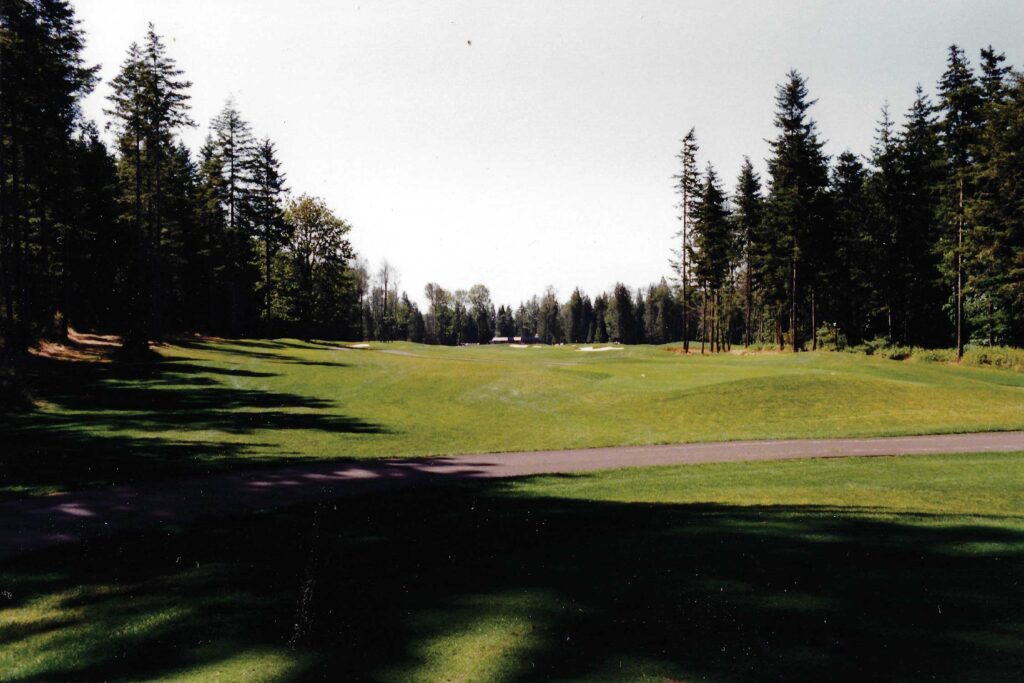
- Driving into the just-opened Arnold Palmer-designed Semiahmoo Golf & Country Club near the Canadian border I noticed a sizable crew crawling on their hands and knees like they were searching for a lost item. Upon arrival, I asked the pro what they were doing. He said they were hand-pulling poa annua from the all-bentgrass course. Oooo-kay. It wasn’t long before Semiahmoo, a fine course, became wall-to-wall poa, an insidious “weed” that always wins in western Washington (see also the formerly all-fescue Chambers Bay – host of the 2010 U.S. Amateur and controversial 2015 U.S. Open).
- Gallery Golf Course at the Whidbey (Island) Naval Air Station was designed by Navy Seabees and opened in 1948. A particularly curious hole is the par-5 fourth, a 475-yard dogleg-right around a barbed-wire compound bearing ominous “Radiation” signs.
- Recently hired head pro Kelly (the last name deliberately removed) at the under-construction Druid’s Glen in Covington decided to give me a close-up look of a just-planted 10th fairway. Unsurprisingly, his four-wheel-drive SUV got mired in the middle of the squishy expanse. A backhoe was needed to extricate the rig. The hole had already been rebuilt twice before as a crossing creek tended to flood. I later learned Kelly’s eagerness to give me a birds-eye view cost the developer another $500,000.
- Once witnessed my brother-in-law Steve hit a dozen balls into a slender creek at Foster Golf Links’ short par-3 fifth hole. The water hazard is maybe 70 yards off the tee. After the round, Steve sold his just-bought golf clubs, bag, tees, glove, whatever balls remained at home and his shoes for $100.
- I nearly aced the 90-yard first hole at Jackson Park’s par-3 course. With a putter. In trying to eliminate wear and tear on undersized grass tees, Seattle’s parks department installed black-rubber mats at all its golf facilities in the late-‘70s. Noticing an erosion rut that ran from the front of the mat all the way to the cup, I gently brushed my “tee” shot into the rut. Giggling, we all watched the ball lazily zigzag downhill in the earthen slot toward the cup, just missing my first ace by an inch.
- A far different short-nine experience is Duke’s Lakeview Golf Challenge in Vancouver. Dubbed the “World’s Toughest Par-3,” the course was designed and built-in 1976 by Duke Wager in his outsized backyard. ESPN once filmed a video of the place. Duke set up the course on a difficulty scale of 1-10. At the higher ratings, Duke placed pins (two per hole for 18-hole rounds) on ultra-slick domed putting surfaces inches from tiny ponds (including one in the middle of green) or on the edges of deep bunkers, one of which was 14-feet deep and accessible by a step ladder. Players in the LPGA Safeway Classic – held since 1972 at Columbia-Edgewater CC across the Columbia River in Portland – would come here for skins games before tournaments. Duke proudly told me that one of the pros racked up a 61 on a single hole.
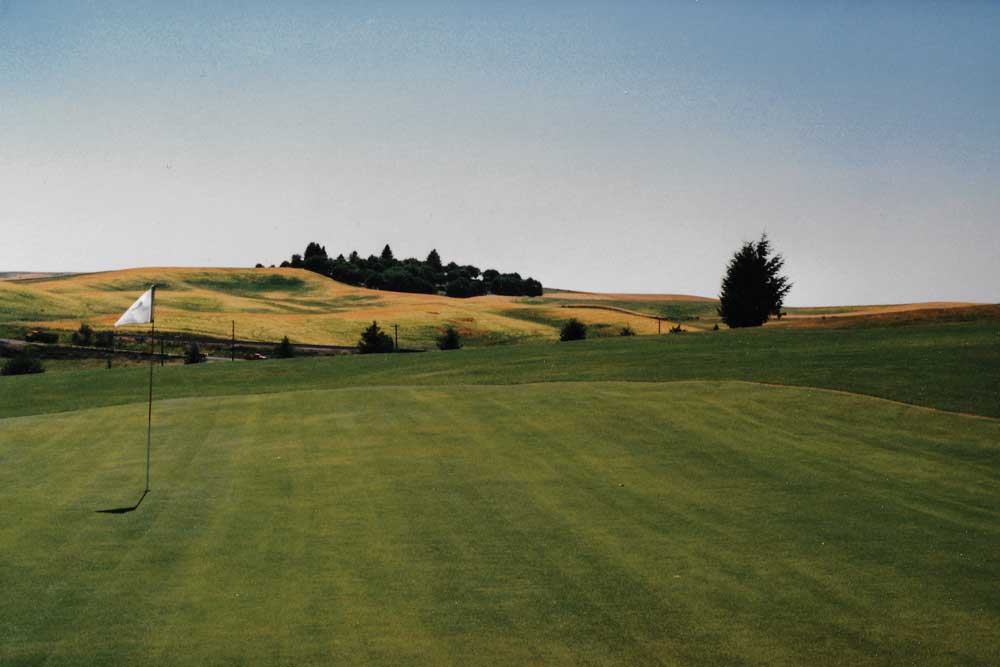
- I found one of the prettiest “entrances” to a golf course in the farming town of Tekoa (pronounced “Tee-Ko”), home of an eponymous nine-hole layout. Located in the geographically unique Palouse country of southeast Washington and the Latah Valley, the surroundings here are sublime. In spring, everywhere one looks are rolling, multi-hued wheat and alfalfa fields.
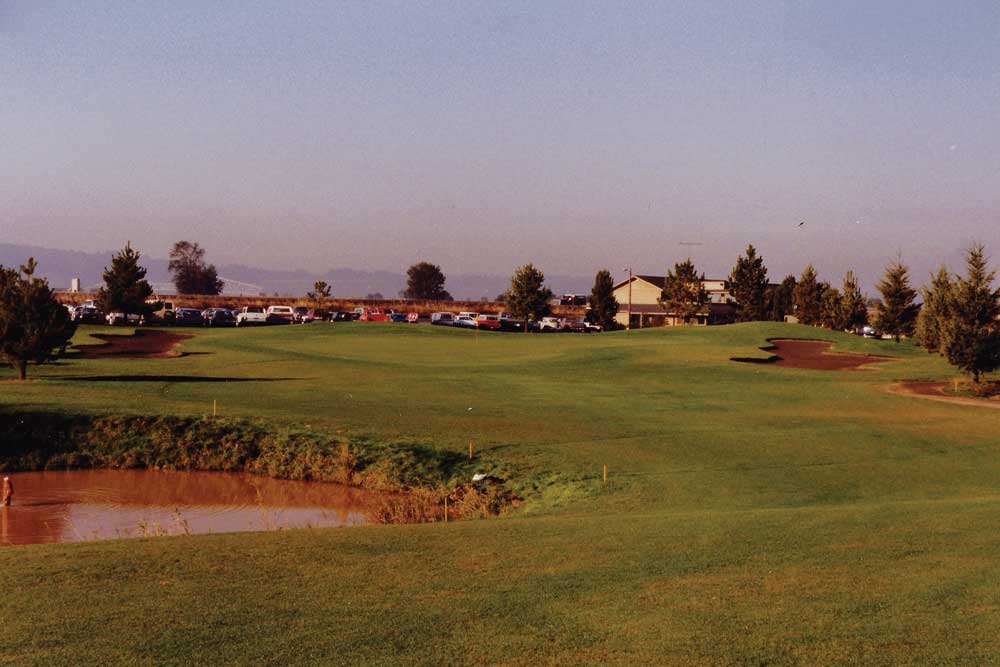
- A couple of tales from southwest Washington: Ralph Stading owned and lived at Lewis River GC in Woodland, the closest course to Mount St. Helens. When asked what he did during the eruption, Stading answered, “I brought out a lawn chair, drank beer and watched it.” Thankfully for him, the ash and rock plume from America’s largest recorded volcanic explosion – which ripped 1,300 feet off the mountain and killed 57 people – blew to the northeast away from Ralph’s ringside seat. Not far away is Hartwood GC in Brush Prairie, a nine-holer built on a farm. The owner-builders, the Hart family, showed me a mint Aerocar in their barn. University of Washington-trained aeronautical engineer Molt Taylor designed and built the extremely rare flying car in 1949. Only six were ever made and it never entered production.
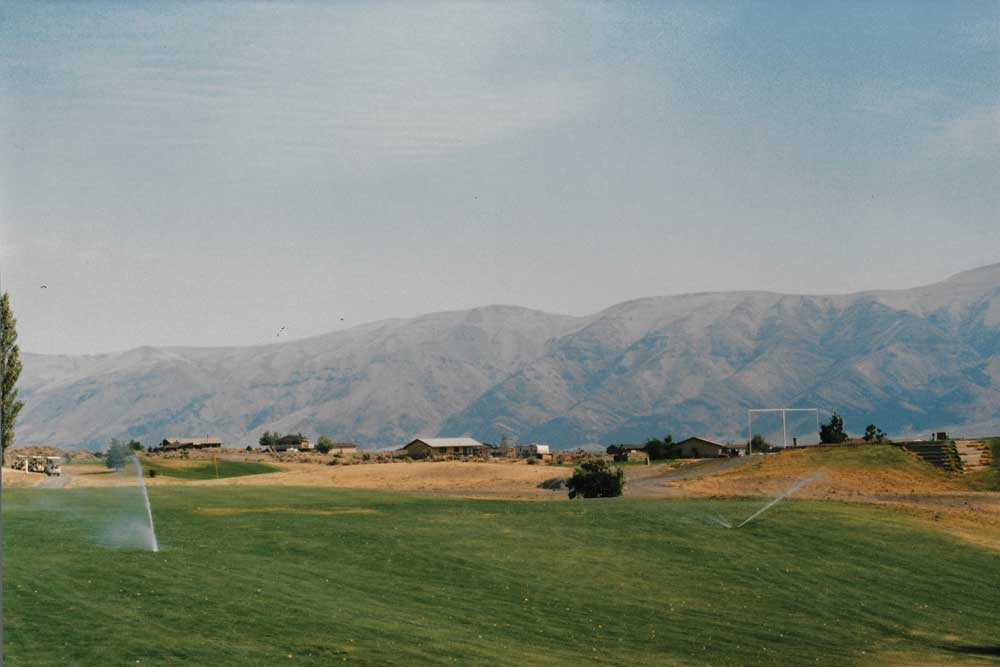
- Two irrigation stories: The wind whips so fast at Desert Aire in Mattawa in arid central Washington that the water gets less than halfway around its circle, while on the opposite side it blusters well over 100 feet and likely evaporates before finding turf. And there’s Quincy Valley Golf Course (now Colockum Ridge), also on the state’s “dry side.” Its 18 holes use a center pivot irrigation system, the same used for growing wheat and other vast tracts of low-growing crops. Larger systems can cover 125 acres on a single rotation. Trees at this golf course must be shorter than 8 feet tall or get knocked over.
- Grew up in Yakima. The central Washington city is called “The Palm Springs of Washington” (it averages a mere 9 inches of annual precipitation) and “The Fruitbowl of the Nation” because of its thousands of acres of apple, cherry, pear, and plum orchards. I lived in the West Valley section of the city, right next to nine-hole Westwood West, whose fairways – naturally – are lined by apple trees. As high school freshmen, my friend Nick and I would sneak onto the second hole. It would be years before I ever played the opening hole. The course designer and original head pro, Curley Hueston, would spy us under the branches and angrily take off in his three-wheeled Harley Davidson golf cart. He never came close to nabbing us. Maybe my favorite memory is coming home in the fall with golf clubs shiny and sticky from smacking unharvested apples that had dropped to the ground.
All the above photos are courtesy Jeff Shelley.
Jeff Shelley has written and published nine books as well as numerous articles for print and online media during his lengthy career. The Seattle resident co-founded the Northwest Golf Media Association in 1995. He co-authored (with Michael Riste) “Championships & Friendships: The First 100 Years of the Pacific Northwest Golf Association.” Other titles include three editions of the book, “Golf Courses of the Pacific Northwest.”
Read other in Jeff’s Series of Making the Rounds – https://www.golfcoursetrades.com/author/jshelley/

